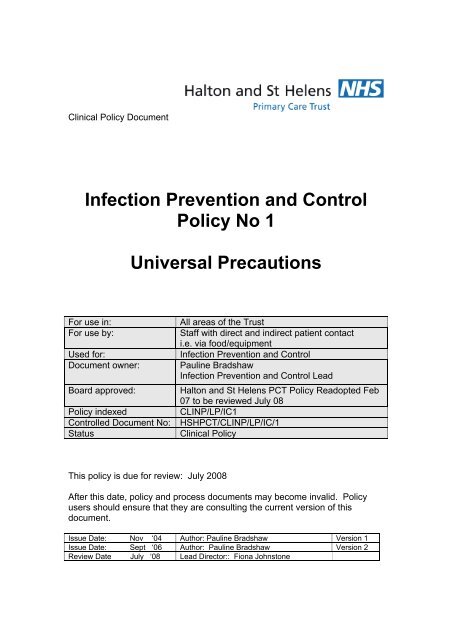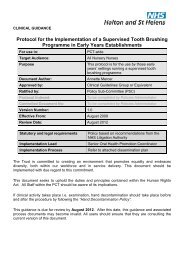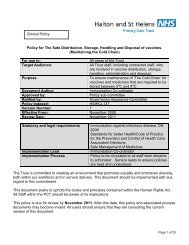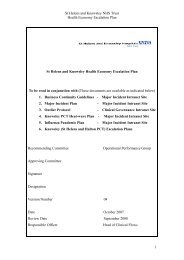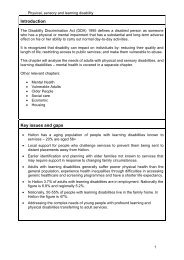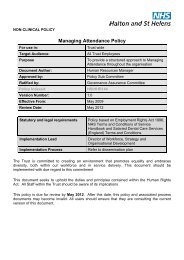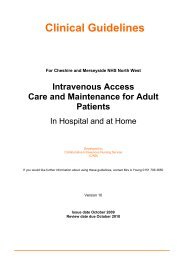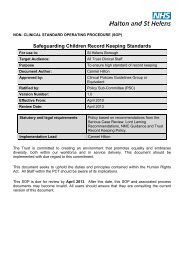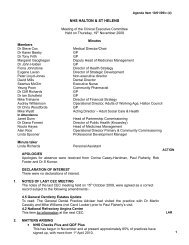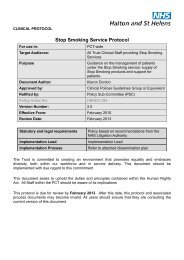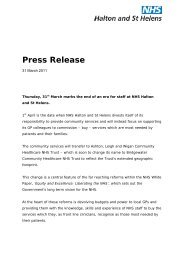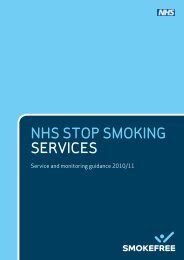Infection Prevention and Control Policy No 1 Universal Precautions
Infection Prevention and Control Policy No 1 Universal Precautions
Infection Prevention and Control Policy No 1 Universal Precautions
Create successful ePaper yourself
Turn your PDF publications into a flip-book with our unique Google optimized e-Paper software.
Clinical <strong>Policy</strong> Document<br />
<strong>Infection</strong> <strong>Prevention</strong> <strong>and</strong> <strong>Control</strong><br />
<strong>Policy</strong> <strong>No</strong> 1<br />
<strong>Universal</strong> <strong>Precautions</strong><br />
For use in:<br />
For use by:<br />
Used for:<br />
Document owner:<br />
Board approved:<br />
<strong>Policy</strong> indexed<br />
<strong>Control</strong>led Document <strong>No</strong>:<br />
Status<br />
All areas of the Trust<br />
Staff with direct <strong>and</strong> indirect patient contact<br />
i.e. via food/equipment<br />
<strong>Infection</strong> <strong>Prevention</strong> <strong>and</strong> <strong>Control</strong><br />
Pauline Bradshaw<br />
<strong>Infection</strong> <strong>Prevention</strong> <strong>and</strong> <strong>Control</strong> Lead<br />
Halton <strong>and</strong> St Helens PCT <strong>Policy</strong> Readopted Feb<br />
07 to be reviewed July 08<br />
CLINP/LP/IC1<br />
HSHPCT/CLINP/LP/IC/1<br />
Clinical <strong>Policy</strong><br />
This policy is due for review: July 2008<br />
After this date, policy <strong>and</strong> process documents may become invalid. <strong>Policy</strong><br />
users should ensure that they are consulting the current version of this<br />
document.<br />
Issue Date: <strong>No</strong>v ‘04 Author: Pauline Bradshaw Version 1<br />
Issue Date: Sept ‘06 Author: Pauline Bradshaw Version 2<br />
Review Date July ‘08 Lead Director:: Fiona Johnstone
CONTENTS<br />
1. Introduction 1<br />
1.1 Status 1<br />
1.2 Purpose 1<br />
1.3 Scope 1<br />
2. General <strong>Policy</strong> Statement 1<br />
3. Components of <strong>Universal</strong> <strong>Precautions</strong> 2<br />
3.1 H<strong>and</strong> Decontamination 2<br />
3.2 Personal Protective Equipment 2<br />
3.2.1 Gloves 2<br />
4. Needle <strong>and</strong> Sharp Instrument Safety 3<br />
5. Environmental Cleaning <strong>and</strong> Disinfection 4<br />
6. Blood Spills 4<br />
7. Contaminated Medical Devices 4<br />
8. Linen 4<br />
9. Isolation <strong>Precautions</strong> 5<br />
10. Waste 5<br />
Further advice 6<br />
References 7
1. Introduction<br />
<strong>Universal</strong> or St<strong>and</strong>ard <strong>Infection</strong> <strong>Control</strong> <strong>Precautions</strong> are based on the premise<br />
that a health care recipients infectious status is unknown, <strong>and</strong> that contact<br />
with blood, body fluids, broken skin <strong>and</strong> mucous membranes may pose a risk<br />
of transmission of micro-organisms. All body fluids are therefore regarded as<br />
potentially infectious.<br />
1.1 Status<br />
This is a Clinical <strong>Policy</strong> Document<br />
1.2 Purpose<br />
This policy contains measures to protect health care workers against infection<br />
from blood, body fluids, broken skin <strong>and</strong> mucous membranes.<br />
1.3 Scope<br />
This policy applies to all staff (permanent <strong>and</strong> temporary) who come into<br />
contact with blood, body fluids, broken skin or mucous membranes<br />
2. General <strong>Policy</strong> Statement<br />
All staff with direct/indirect patient contact must take appropriate precautions<br />
to prevent person to person spread of infection. It is the responsibility of the<br />
Primary Care Trust to ensure all staff have access to personal protective<br />
clothing.<br />
1
3. Components of <strong>Universal</strong> <strong>Precautions</strong><br />
3.1 H<strong>and</strong> Decontamination<br />
Decontamination covers all the processes required to remove<br />
pathogenic organisms that may be carried on the h<strong>and</strong>s, i.e. washing<br />
with liquid soap <strong>and</strong> water, use of alcohol rub/gel.<br />
H<strong>and</strong>s should be decontaminated when visibly dirty, when they may<br />
have become contaminated with micro-organisms <strong>and</strong> before <strong>and</strong> after<br />
contact with a vulnerable patient or a susceptible site on a patient.<br />
Alcohol h<strong>and</strong> rub gel may be used if h<strong>and</strong>s are visibly clean. If h<strong>and</strong>s<br />
are visibly contaminated with dirt organic matter alcohol will be<br />
ineffective <strong>and</strong> liquid soap <strong>and</strong> water must be used first. Build up of<br />
residue from alcohol gels/rubs on the h<strong>and</strong>s must be washed off<br />
periodically, i.e. after every 3-4 applications as continued build up will<br />
prevent alcohol penetration to the skin. (Please refer to <strong>Infection</strong><br />
<strong>Prevention</strong> <strong>and</strong> <strong>Control</strong> <strong>Policy</strong> <strong>No</strong> 2 H<strong>and</strong> Decontamination for further<br />
guidance).<br />
Minor cuts <strong>and</strong> grazes should be covered by a waterproof dressing,<br />
which is replaced if integrity becomes compromised.<br />
3.2 Personal Protective Equipment<br />
3.2.1 Gloves<br />
Gloves should be worn whenever contact with blood/body fluids is<br />
anticipated. In situations where the risk of contact with blood/blood<br />
stained fluids is low, a vinyl non-sterile glove is usually appropriate.<br />
Sterile/aseptic procedures require sterile gloves.<br />
Where there is regular contact with blood/blood stained fluids, gloves<br />
should conform to BSEN 455 parts 1, 2 <strong>and</strong> 3. A suitable alternative to<br />
natural rubber latex should be chosen if possible, i.e. nitrile,<br />
polychloroprene or vinyl (if complies with BSEN 455 parts 1, 2 <strong>and</strong> 3<br />
glove manufacturer will advise).<br />
During procedures where a degree of manual dexterity is required,<br />
gloves should be chosen that fit comfortably <strong>and</strong> allow full range of<br />
h<strong>and</strong> movements.<br />
H<strong>and</strong>s must always be decontaminated after glove removal.<br />
In addition to gloves wear a mask, protective eyewear <strong>and</strong> disposable<br />
gown/apron during any patient care activity when splashes or sprays of<br />
body fluids are likely.<br />
2
Wear a disposable plastic apron when there is a risk of staff clothing<br />
becoming wet, when in close contact with the patient or with their linens<br />
<strong>and</strong> when h<strong>and</strong>ling food. The usual colour coding for aprons is: white –<br />
general patient care <strong>and</strong> aseptic procedures, blue – food h<strong>and</strong>ling <strong>and</strong><br />
green – minor surgery.<br />
Immediately following use, disposable equipment such as gloves,<br />
masks, gowns <strong>and</strong> aprons are disposed of as clinical waste. <strong>No</strong>ndisposable<br />
items are cleaned <strong>and</strong> disinfected in accordance with the<br />
manufacturers guidelines.<br />
4 Needle <strong>and</strong> Sharp Instrument Safety<br />
The user of needles <strong>and</strong> other sharp instruments are responsible for<br />
their safe use <strong>and</strong> disposal. Do not recap needles. Do not pass<br />
unprotected sharp instruments from person to person by h<strong>and</strong>.<br />
Immediately following use, dispose of non-reusable needles, syringes<br />
<strong>and</strong> other sharp patient-care instruments into puncture resistant<br />
containers (sharps containers are required to be compliant to BS 7320<br />
1990). Sharps containers are replaced when no more than ¾ full. In<br />
surgical settings the disposal of needles <strong>and</strong> other sharps may not be<br />
immediate due to the need to count needles <strong>and</strong> scalpel blades prior to<br />
<strong>and</strong> after closure of the surgical site, in these instances needles <strong>and</strong><br />
blades should be placed on a discard pad <strong>and</strong> disposed of as one unit<br />
into the sharps container.<br />
Used hypodermic needles with syringes <strong>and</strong> other used sharp medical<br />
instruments may at times be discarded in inappropriate areas. Great<br />
care needs to be taken when retrieving these items for safe disposal,<br />
personal protective clothing as described above is required to be worn,<br />
h<strong>and</strong>s should not come into direct contact with the sharp device, long<br />
h<strong>and</strong>led forceps, pliers or a dust pan <strong>and</strong> brush may be safely used to<br />
place the item directly into a sharps container. The person who does<br />
this task is required to have received training in <strong>Universal</strong> (St<strong>and</strong>ard)<br />
<strong>Precautions</strong> <strong>and</strong> will have been offered Hepatitis B immunisation. If<br />
devices are found outside of Trust property on public or council l<strong>and</strong><br />
then notify St Helens Cleansing Department Customer Services<br />
(01744 456470).Halton Borough Council / regeneration neighbourhood<br />
Services 0151 907 8300.<br />
If injury occurs from a needle/sharp instrument, follow immediate first<br />
aid action:-<br />
• Encourage to bleed, wash with soap <strong>and</strong> water<br />
• Apply water proof plaster dressing<br />
• Follow further guidance in <strong>Infection</strong> <strong>Prevention</strong> <strong>and</strong> <strong>Control</strong><br />
<strong>Policy</strong> <strong>No</strong> 6. Management of occupational exposure to blood<br />
borne viruses <strong>and</strong> post exposure prophylaxis.
5. Environmental Cleaning <strong>and</strong> Disinfection<br />
3<br />
In clinic settings surfaces, including patient care equipment <strong>and</strong><br />
furniture, are routinely cleaned using detergent <strong>and</strong> water. Items<br />
contaminated with blood or body fluids are first cleaned <strong>and</strong> rinsed <strong>and</strong><br />
then disinfected using a 10,000 parts per million available chlorine<br />
releasing agent. The same procedure is used for general disinfection<br />
except 1,000 parts per million available chlorine releasing agent is<br />
used.<br />
6. Blood Spills<br />
Spills of blood or of body fluids stained with blood are dealt with<br />
immediately. A member of staff wears the appropriate level of personal<br />
protective equipment, <strong>and</strong> then sprinkles the spill with NaDCC (Sodium<br />
Dichloroisocyanurate) granules. This compound absorbs the spill <strong>and</strong><br />
deactivates any micro-organisms, the resulting material is then<br />
disposed of in a clinical waste bag <strong>and</strong> the site is cleaned using<br />
detergent <strong>and</strong> water. Care must be taken when using the granules that<br />
there is sufficient ventilation. Granules should not be used on<br />
chemicals or mixed with other cleaners.<br />
If NaDCC granules are not available, i.e. in a patients home, the spill<br />
should be absorbed using paper/kitchen towels <strong>and</strong> the site cleaned<br />
<strong>and</strong> disinfected. Personal protective equipment should be worn <strong>and</strong><br />
waste disposed of in a clinical waste bag. In the home environment<br />
care needs to be taken that cleaning agents are not damaging to<br />
furnishings.<br />
7. Contaminated Medical Devices<br />
Contaminated reusable medical devices are not reused on another<br />
patient until decontaminated, <strong>and</strong> the appropriate level of disinfection<br />
<strong>and</strong>/or sterilisation has occurred. Used <strong>and</strong> unused devices are stored<br />
separately in locations/containers that minimise the risk of injury <strong>and</strong><br />
cross infection. Single use devices are appropriately disposed of<br />
immediately after use.<br />
8. Linen<br />
Linen contaminated with blood or body fluids should be placed inside a<br />
red plastic water-soluble bag, <strong>and</strong> then securely tied before placing<br />
inside a red fabric bag. The outer bag is then securely fastened,<br />
labelled with the contents <strong>and</strong> the name <strong>and</strong> address of the facility, <strong>and</strong><br />
then left in the designated area for transport to the laundry.<br />
4
Care must be taken not to overfill either the inner or outer bags. Avoid<br />
direct contact with items soiled with blood <strong>and</strong> body fluids by using the<br />
appropriate level of personal protective equipment. As far as possible<br />
disposable linen should be used<br />
9. Isolation <strong>Precautions</strong><br />
In a clinic setting patients who are unable to control their body<br />
substances due to diarrhoea, bleeding, urinary incontinence, vomiting,<br />
draining lesions, or uncontrollable or severe coughing, need to be<br />
withdrawn from the public waiting area <strong>and</strong> placed in an examination<br />
room. Isolation is not required if urinary incontinence is controlled by<br />
effective incontinence aids, or if wounds or lesions are covered with an<br />
intact dressing that is not soaked through.<br />
10. Waste<br />
All waste contaminated with blood or body fluids should be discarded<br />
into yellow plastic bags for incineration. The top of the bag is securely<br />
tied <strong>and</strong> care is taken to ensure that no fluid leaks from the bag. If<br />
there is a risk of leakage place inside a second yellow bag or in a more<br />
rigid clinical waste receptacle. Please follow Interim <strong>Infection</strong> <strong>Control</strong><br />
<strong>Policy</strong> <strong>No</strong>.8 Safe Disposal of Clinical Waste
5<br />
For further advice contact:<br />
Pauline Bradshaw<br />
<strong>Infection</strong> <strong>Prevention</strong> <strong>and</strong> <strong>Control</strong> Lead<br />
Halton <strong>and</strong> St Helens Primary Care Trust<br />
Tel <strong>No</strong>: 01744 674001<br />
Mob <strong>No</strong>: 07917 001742<br />
e.mail: pauline.bradshaw@hsthpct.nhs.uk<br />
Jeanette Owens<br />
<strong>Infection</strong> <strong>Prevention</strong> <strong>and</strong> <strong>Control</strong> Nurse<br />
Halton <strong>and</strong> St Helens Primary Care Trust<br />
Tel <strong>No</strong>: 01744 611501<br />
Mob <strong>No</strong>: 07917 00 1729<br />
e.mail: jeanette.owens@hsth.nhs.uk<br />
6
References<br />
Advisory Committee on Dangerous Pathogens. (1995) Categorisation of<br />
Pathogens According to Hazard <strong>and</strong> Categories of containment. Fourth<br />
Edition London: HMSO.<br />
Advisory Committee on Dangerous Pathogens. (1990) HIV – The<br />
Causative Agent of AIDS <strong>and</strong> Related Conditions. Second Revision of<br />
Guidelines (<br />
Advisory Committee on Dangerous Pathogens. (1990) Protection against<br />
blood-borne infections in the workplace: HIV <strong>and</strong> Hepatitis. HMSO<br />
British Medical Association (BMA). (1990)<br />
use <strong>and</strong> Disposal of Sharps. BMA. June<br />
A Code of Practice for the Safe<br />
Department of Health (DOH). (1993) Decontamination of equipment,<br />
linen or other surfaces contaminated with Hepatitis B <strong>and</strong>/or HIV. HC<br />
(91) 33.<br />
Department of Health (DOH). (1995)<br />
used <strong>and</strong> infected linen for HSG 18.<br />
Hospital laundry arrangements<br />
Department of Health (DOH). (1998) Guidance for Clinical Health Care<br />
Workers. Protection against infection with Blood Borne Viruses. UK<br />
Health Departments. HSC 063<br />
Garner, J S, Hospital <strong>Infection</strong> <strong>Control</strong> Practices Advisory Committee(1996)<br />
Guideline for Isolation <strong>Precautions</strong> In Hospitals, Centers for Disease<br />
<strong>Control</strong> <strong>and</strong> <strong>Prevention</strong>, Public Health Service, US Department of Health <strong>and</strong><br />
Human Services, Atlanta, Georgia.<br />
Health Services Advisory Committee (HSAC) (1990)<br />
Clinical Waste HSAC HMSO.<br />
. Safe Disposal of<br />
ICNA (2002) Protective Clothing (Principles <strong>and</strong> Guidance).<br />
RCN (2000) <strong>Universal</strong> <strong>Precautions</strong> for the <strong>Control</strong> of <strong>Infection</strong>.<br />
7


